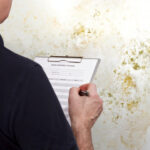Wondering if there’s mold in your home?
This guide shows you how to test for mold in house, recognize early warning signs, check hidden areas, and safely remove mold before it spreads. If you’re asking what to do if you have mold in your house, this is your all-in-one homeowner guide.
Early Signs of Mold in House
Catch mold early with these common warning signs:
- Musty or damp smell (especially in basements or closets)
- Black, green, or white spots on walls, ceilings, or tiles
- Peeling paint or bubbling wallpaper
- Increased allergies or asthma symptoms at home
- Visible moisture or high humidity (above 60%)
Tip: If you can smell mold, it’s likely already growing—even if you can’t see it.
🔍 Where to Look for Mold in House
Mold loves dark, damp, poorly ventilated spaces. Check:
- Bathrooms: Under sinks, behind toilets, around tubs
- Kitchens: Behind appliances, under sinks, near water lines
- Basement or Crawlspace: Around sump pumps, along foundation walls
- Attic: Near roof leaks, vents, or insulation
- HVAC Systems: Inside ducts, filters, and drip pans
- Windows: On sills, frames, or any area with condensation
🧪 How to Test for Mold in House
1. Do a Visual Inspection
Use a flashlight and check hidden areas: behind furniture, inside closets, under sinks, and along walls and ceilings. Look for:
- Black or fuzzy spots
- Water stains or discoloration
- Warped wood or peeling paint
2. Smell for Musty Odors
A strong, musty odor is often the first sign of mold—even before it becomes visible.
3. Use Moisture Tools
- Moisture meter: Detects dampness in walls and floors
- Hygrometer: Monitors room humidity (keep it under 50%)
4. Try a DIY Mold Test Kit
You can find mold testing kits at most hardware stores. They include:
- Surface swabs
- Air sampling
- Lab testing options
⚠️ DIY tests may not detect hidden mold. For full peace of mind, hire a certified inspector.
5. Call a Professional Mold Inspector
A licensed expert will use:
- Air quality testing
- Infrared imaging
- Moisture mapping
- Detailed lab analysis
Best for hidden mold, black mold concerns, or if you’re buying/selling a home.
🧼 How to Remove Mold from Your House (Safely and Effectively)
If you’ve found mold, here’s how to remove it—and keep it from coming back.
✅ Step 1: Fix the Moisture Problem
Stop the source before cleaning:
- Repair leaks in plumbing, roofing, or walls
- Improve ventilation in damp rooms
- Use a dehumidifier to keep humidity under 50%
💡 Mold removal won’t work if the moisture remains.
✅ Step 2: Protect Yourself
Wear proper safety gear:
- N95 mask or respirator
- Gloves
- Goggles
- Long sleeves
Also:
- Seal off the work area with plastic
- Turn off HVAC systems to avoid spreading spores
✅ Step 3: Clean or Remove Moldy Materials
Hard, non-porous surfaces (tile, glass, metal):
- Scrub with soap and warm water
- Disinfect with vinegar or 3% hydrogen peroxide
- Dry completely
Porous materials (drywall, carpet, insulation):
- Usually must be removed and replaced
Wood surfaces:
- Scrape mold with a stiff brush
- Apply vinegar or mold-killing solution
- Let dry fully
⚠️ Avoid bleach. It doesn’t penetrate porous materials and can release harmful fumes.
✅ Step 4: Dry the Area Thoroughly
Use:
- Fans
- Dehumidifiers
- Open windows (if weather allows)
Mold can regrow in as little as 48 hours if surfaces stay damp.
✅ Step 5: Prevent Mold from Coming Back
- Ventilate bathrooms, kitchens, and laundry areas
- Fix future leaks fast
- Insulate cold surfaces to prevent condensation
- Monitor damp zones like basements and attics
- Clean HVAC filters regularly
Found black mold or a large infestation? Call a professional remediation company.
Mold Removal Checklist
| Task | Action |
|---|---|
| Stop Moisture | Fix leaks, dry areas |
| Gear Up | Wear gloves, mask, goggles |
| Clean | Use vinegar or peroxide |
| Discard | Remove moldy carpet or drywall |
| Dry | Use fans and dehumidifiers |
| Prevent | Control humidity and airflow |
What to Do If You Find Black Mold in Your House
Black mold (Stachybotrys chartarum) is toxic and should never be cleaned without proper equipment.
- Do not scrub or disturb it
- Seal off the area
- Contact a licensed mold remediation company immediately
How to Prevent Mold in the Future
- Run exhaust fans while cooking or showering
- Use mold-resistant paint in damp areas
- Clean air ducts and filters regularly
- Keep home humidity between 30–50%
- Inspect basements, attics, crawlspaces, and windows quarterly
❓ Mold FAQs
Can I remove the mold myself?
Yes—if the area is small (under 10 sq. ft.), not black mold, and on hard surfaces. Wear protection and address moisture first.
How do I know if there’s hidden mold?
Use a moisture meter or hire a mold inspector. Musty smells and water damage are good clues.
How long does it take mold to grow after water damage?
Mold can begin growing in as little as 24–48 hours in damp, unventilated conditions.
Does bleach or vinegar kill mold better?
Vinegar is better. It kills most mold types and penetrates surfaces. Bleach only removes surface stains and can be toxic.
Is it safe to clean white mold yourself?
Yes—if it’s a small area and you wear proper protection. When in doubt, or if symptoms appear, call a professional.
What is the safest thing to clean mold with?
White vinegar, hydrogen peroxide, or baking soda are safe, non-toxic options. Avoid bleach, especially on porous materials.
Final Thoughts: Act Fast & Stay Mold-Free
If you’ve noticed any signs of mold, the most important thing is to act quickly. Mold spreads fast, can damage your home, and may harm your health.
If the mold problem is extensive, keeps coming back, or involves black mold, it’s best to consult a licensed mold remediation specialist in your area.
Also, don’t forget to understand what your insurance covers. Mold cleanup can get costly, especially after water damage or hidden leaks.
👉 Learn more about does home insurance cover mold so you know what to expect from your policy.

